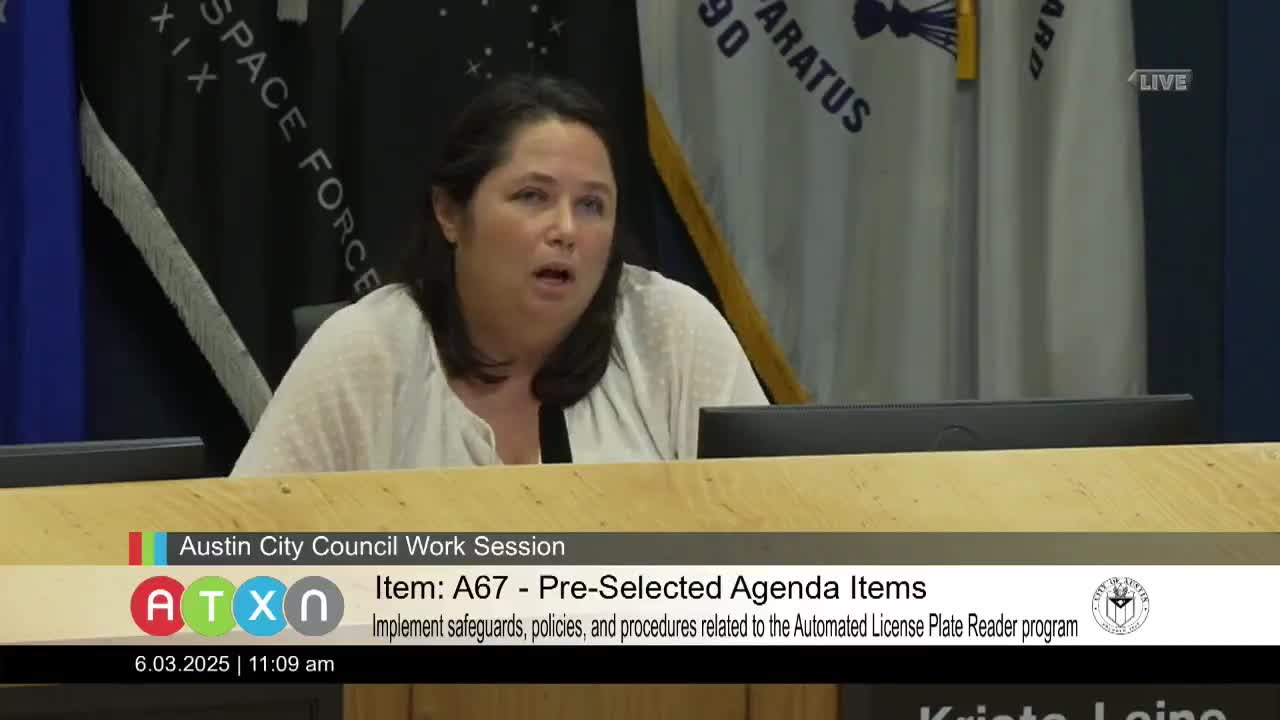Austin Council discusses impact of license plate readers on crime statistics
June 03, 2025 | Austin, Travis County, Texas
This article was created by AI summarizing key points discussed. AI makes mistakes, so for full details and context, please refer to the video of the full meeting. Please report any errors so we can fix them. Report an error »

The Austin City Council held a work session on June 3, 2025, focusing on public safety, transparency in law enforcement, and the effectiveness of the Automated License Plate Reader (ALPR) system. The meeting began with discussions on the need for improved access to information regarding fire incidents, particularly in areas of Travis County where residents feel disconnected from law enforcement activities.
Council members expressed concerns about the lack of transparency and communication regarding police presence and activities in certain districts. One council member highlighted that a significant portion of their district lacks access to the active incident fire dashboard, which limits residents' ability to stay informed about local safety issues. They emphasized the importance of including all jurisdictions in data sharing to enhance community awareness and trust.
The session also addressed the effectiveness of the ALPR system in recovering stolen vehicles. A council member inquired about the statistics related to vehicle recovery rates before and after the implementation of ALPR. The police department reported that during the pilot period, there were 4,664 auto thefts, with 245 vehicles recovered using the ALPR system, indicating a recovery rate of approximately 5%.
Further discussions included the challenges of attributing crime clearance rates directly to the ALPR system, as multiple factors contribute to investigations. The police chief noted that while ALPR is a valuable tool, it is used in conjunction with other investigative methods, making it difficult to quantify its singular impact on crime resolution.
The meeting concluded with a commitment to continue exploring ways to enhance public safety and improve communication between law enforcement and the community. Council members acknowledged the need for ongoing dialogue and data sharing to address the concerns raised by constituents effectively.
Council members expressed concerns about the lack of transparency and communication regarding police presence and activities in certain districts. One council member highlighted that a significant portion of their district lacks access to the active incident fire dashboard, which limits residents' ability to stay informed about local safety issues. They emphasized the importance of including all jurisdictions in data sharing to enhance community awareness and trust.
The session also addressed the effectiveness of the ALPR system in recovering stolen vehicles. A council member inquired about the statistics related to vehicle recovery rates before and after the implementation of ALPR. The police department reported that during the pilot period, there were 4,664 auto thefts, with 245 vehicles recovered using the ALPR system, indicating a recovery rate of approximately 5%.
Further discussions included the challenges of attributing crime clearance rates directly to the ALPR system, as multiple factors contribute to investigations. The police chief noted that while ALPR is a valuable tool, it is used in conjunction with other investigative methods, making it difficult to quantify its singular impact on crime resolution.
The meeting concluded with a commitment to continue exploring ways to enhance public safety and improve communication between law enforcement and the community. Council members acknowledged the need for ongoing dialogue and data sharing to address the concerns raised by constituents effectively.
View full meeting
This article is based on a recent meeting—watch the full video and explore the complete transcript for deeper insights into the discussion.
View full meeting
